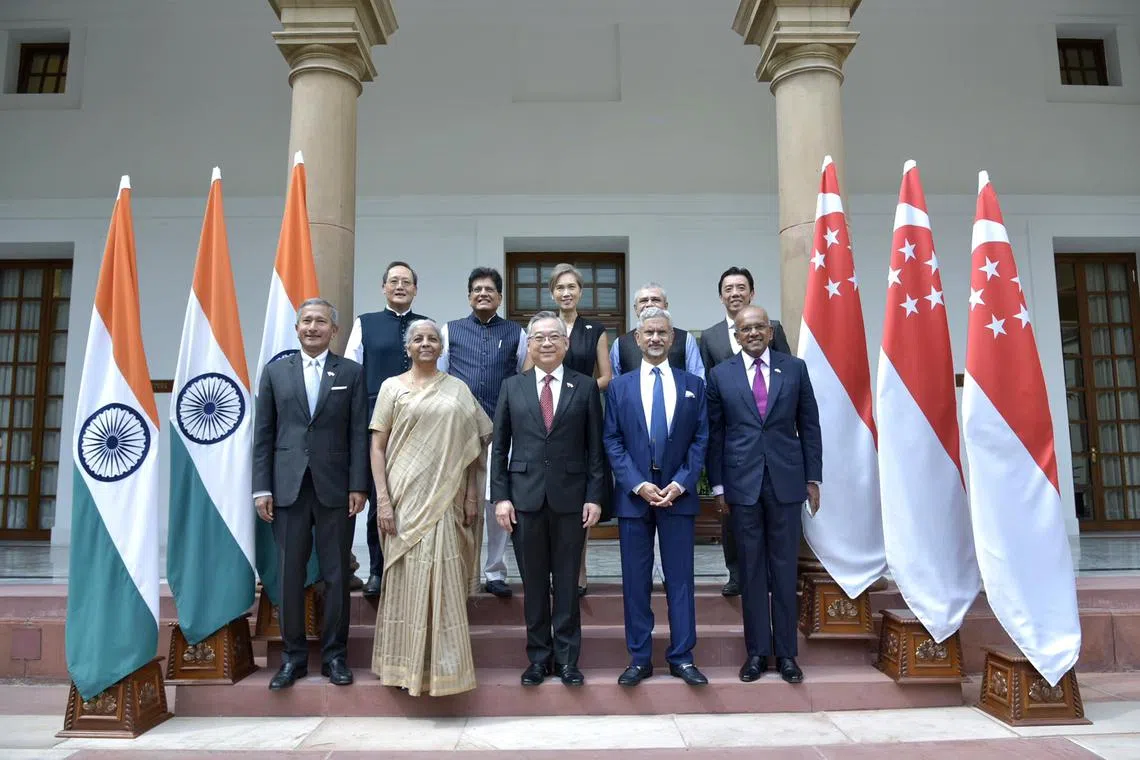Strong India-Singapore ties key to economic growth amid ‘volatile landscape’: DPM Gan
Sign up now: Get ST's newsletters delivered to your inbox

DPM Gan Kim Yong, flanked by India’s Minister of Finance and Corporate Affairs Nirmala Sitharaman and External Affairs Minister S. Jaishankar, in New Delhi on Aug 13.
PHOTO: INDIA’S MINISTRY OF EXTERNAL AFFAIRS
Follow topic:
NEW DELHI – As India and Singapore explore newer areas of cooperation such as nuclear energy and green initiatives, Deputy Prime Minister Gan Kim Yong said the two Asian partners needed to collaborate even more, given the increasingly “volatile landscape” globally.
DPM Gan, who was on an official trip to India earlier this week, visited the financial capital Mumbai on Aug 12 to look at Singapore projects.
He then led the Singapore delegation at the third edition of the India-Singapore Ministerial Roundtable (ISMR)
The ISMR, which held its first meeting in 2022, is a high-level ministerial gathering that is now at the heart of engagement between the two countries, with both sides exploring and implementing cooperation in a wide range of areas – from nuclear energy to semiconductors to skills training in India.
Speaking to the Singapore media late on Aug 13 in New Delhi, DPM Gan said Singapore could learn from India’s experience in nuclear power, as the Republic keeps the option open for future deployment of such energy.
While Singapore has not made a decision on its nuclear energy plans, it is studying developments in the field, such as small modular reactors (SMRs), as other nations in South-east Asia move towards nuclear energy.
SMRs are advanced and compact reactors that can be factory-assembled and installed in dense urban areas.
They are also known to be safer than traditional large reactors, but are mainly still in a research phase.
India, which has over two dozen nuclear reactors, is now developing SMRs as part of its transition to clean energy.
The South Asian country is committed to achieving net-zero emissions by 2070
DPM Gan said India had agreed to help Singapore connect with its atomic agencies “to see how we can work together to learn about safety standards and... their practices and their regulations on nuclear safety”.
He added that Singapore will “continue to keep this option open and to study the potential deployment of such nuclear technology”.
“But it is still early days,” he noted.
India has a strict nuclear liability law that places the responsibility for any accident on the operator of a nuclear power plant, not the manufacturer.
The law has spooked foreign firms, with countries including the US seeking an easing of the law, which India is reportedly looking into.
DPM Gan said: “We are still continuing to explore different technologies, because some of the technologies are not mature yet, and therefore we will continue to monitor the development of nuclear technology, particularly in nuclear energy.”

DPM Gan Kim Yong calling on Indian President Droupadi Murmu in New Delhi on Aug 13.
PHOTO: PRESS INFORMATION BUREAU OF INDIA
In 2024, Singapore and the US signed an agreement
The Republic also signed a broad agreement with France
Singapore’s desire to learn from India on nuclear energy also underpins their close political and economic ties and strong people-to-people links.
Successive leaders in Singapore have seen the potential benefit of pursuing close ties with India even before the country started registering rapid economic growth over the past two decades.
The current Singapore leadership has maintained its positive outlook towards India, despite the trade chaos caused by US President Donald Trump’s tariffs
The Trump administration imposed 50 per cent tariffs on Indian goods, while Singapore faces a 10 per cent tariff.
“And going forward the next five, 10 years, the outlook, as I highlighted, is very uncertain,” DPM Gan said.
“Even as we confront a more challenging and more uncertain, more volatile landscape that we are seeing going forward, it is very important for countries that are like-minded to come together, to work together, to see how we can further deepen our collaboration and deepen our integration so that we can continue to explore opportunities for our businesses and our people,” he added.
“We are optimistic, as Singapore and India can work towards a stronger partnership going ahead.”
This year marks 60 years of diplomatic relations and the 10th anniversary of the bilateral strategic partnership.
DPM Gan termed closer collaboration in various sectors “a win-win proposition” for both countries.
“By strengthening this partnership between Singapore and India, we will create opportunities for Singapore companies to continue to grow, to expand, to enlarge their market,” he said.
“It helps to grow the Indian economy because we are investing in India, but at the same time, our investments will provide returns for Singapore and company investors, and that will, in turn, strengthen Singapore’s economy and continue to grow and enhance Singapore’s economic strength.”
Opportunities for Singapore firms include India’s focus on boosting infrastructure, expanding green initiatives, including civilian nuclear energy, and developing its high-tech capabilities, such as semiconductors.
Within the ISMR, the two sides are also discussing setting up a sustainable green industrial park in Rajasthan state and collaboration in other green initiatives, such as green fuel exports through a green maritime corridor from India to Singapore.
A memorandum of understanding on a green and digital shipping corridor is under discussion.
“The idea is that climate change is going to be an existential challenge, and therefore, a lot of the industries, businesses are on this transition journey... towards a low-carbon future.
“India is very keen to develop new industrial parks that have this sustainability in mind,” DPM Gan said.
Discussions also centred on cross-border carbon credit trading and the potential of other green energy collaboration.
For instance, Singapore firms have expertise in building and operating solar and wind farms.
DPM Gan, who is also Minister for Trade and Industry, had inaugurated CapitaLand Investment’s first data centre in Navi Mumbai
He noted that the firm is also keen to explore opportunities to invest in green energy to support the needs of the data centre.
“So there are many opportunities for collaboration in the sustainable and green economy,” he said.
The other two areas where collaboration between India and Singapore is growing quickly are in upskilling and semiconductors.
In 2024, Singapore and India exchanged a memorandum of understanding to partner and cooperate in the field of semiconductors.
Major companies such as US chipmaker Micron Technology and Taiwan-based multinational electronics contract manufacturer Foxconn are in the midst of plans to manufacture chips in India, with the demand for supportive industries going up.
This is where Singapore firms can play a role.
“From Singapore’s point of view, it will allow our semiconductor industries to be more resilient in terms of their supply chain.
“From India’s, this will create investment opportunities and job opportunities for the Indian economy,” DPM Gan said.
Some Singapore firms are already in India, while others are looking at the opportunities in the Indian market.
Skilling workers remains a major challenge for India, with a large proportion of its people under 35 years old – more than 65 per cent of the total population – requiring skills training.
Helping India train workers in the semiconductor sector would also be helpful for Singapore, noted DPM Gan.
He said the two sides discussed setting up a training centre particularly on semiconductors, and another training centre on the MRO – maintenance, repair and overhaul – business for the aviation sector.
“And in order for Singapore companies to be able to do so, we will have to ensure that the skills in India are able to meet the needs of these investors and also to make sure that there is an entire semiconductor ecosystem to be able to support the investments of semiconductor industries,” he added.
Singapore is also working with India to improve the training of nurses.
The demand for more nurses in Singapore is due to the high rate of attrition in recent years and growing global demand for such professionals.
“We hope to be able to continue to work with India to improve the standards of training so that they are more aligned with the needs of Singapore, because different countries have different curriculums, different approaches to training, and when they come to Singapore, they may need to undergo certain refresher, certain additional training to be aligned with practices in Singapore,” DPM Gan said.
Singapore is working with training institutes in India “to see how we can adjust and fine-tune the curriculum and training approach so that they are more aligned with what Singapore needs”.
“So, this will enhance the flow of nurses to Singapore,” said DPM Gan.
Still, the growing economic and business links between India and Singapore are not without challenges.
DPM Gan noted that Singapore firms needed to understand that India is very different from Singapore.
While India has been improving the ease of doing business over the years, it still has multiple challenges, ranging from regulatory hurdles for businesses to the need for more skilled workers and further improvement of infrastructure.
“For companies that are interested in exploring opportunities in India, they should always bear in mind that India is a different country, a different regime, a different system from Singapore. They have to keep their minds open and, as they come to India, get to know about the Indian operating environment, work with business leaders here, and get to understand how businesses operate in India,” DPM Gan said.
In addition, he advised Singapore firms to look for a local partner to guide them in India.
These issues were also discussed during the third India-Singapore Business Roundtable (ISBR), which was also held on Aug 13.
The ISBR is a business-led forum that brings together select leaders to identify initiatives that could strengthen the partnership between the business communities in India and Singapore, as well as forge cultural and people-to-people ties.
At the ISMR, DPM Gan was joined by Coordinating Minister for National Security and Minister for Home Affairs K. Shanmugam, Foreign Minister Vivian Balakrishnan, Minister for Digital Development and Information Josephine Teo, Minister for Manpower and Minister-in-charge of Energy and Science & Technology Tan See Leng, as well as Acting Minister for Transport and Senior Minister of State for Finance Jeffrey Siow.
The Indian side was represented by Minister of Finance and Corporate Affairs Nirmala Sitharaman, Minister of External Affairs S. Jaishankar, Minister of Commerce and Industry Piyush Goyal, and Minister for Electronics and Information Technology, Railways, Information and Broadcasting Ashwini Vaishnaw.
DPM Gan noted that despite the challenges for Singapore firms in India, he had a positive outlook on India.
He said the two countries can leverage the “understanding and trust” built over the years to forge a way forward.
“I am quite happy with the progress we have made so far because of the understanding and trust that we have built over the last 60 years between the two countries, between the two leaders, and between the two governments at the minister level and at the business level.”


